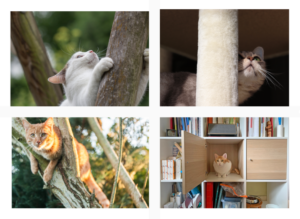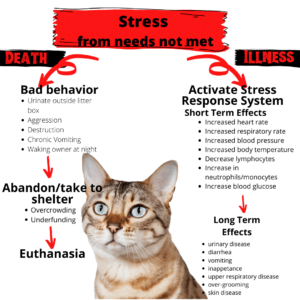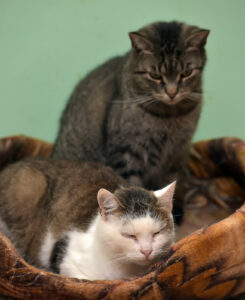Barks Blog
Cats: In Crisis
By Dr. Liz Bales

America loves cats! In fact, we have more cats than dogs living in our homes. We currently live with more than 94 million cats, compared to 90 million dogs (Daily Dog Stuff, n.d.). Nearly half of all millennials have cats: 57% consider their feline friends as important as the humans in their lives and 86% consider their cats to be loyal companions (Purina, 2015).
But even the most passionate cat lovers among us are not always aware that our cats are facing something of a crisis in our homes. While debates rage on about what food to feed your cat and whether you should get your cat from a rescue or a breeder, the most important health crisis facing cats has been getting almost no attention:
The number one cause of death for cats is being unwanted due to behavior problems (Alley Cat Allies, n.d.; Rodan, 2016; Salman et al., 2000; Zito et al., 2016).
Veterinarians and feline behavior scientists have devoted decades to researching this issue and the answer is clear. Cats are very different from humans. This fact may seem obvious, but it is also the root of this epidemic.

Enclosure-free, human-free, outdoor living can be fraught with risks, but it does allow cats to design their lives according to their natural instincts, i.e. where to live, who to live with, how to communicate, what and how to eat, and where and when to eliminate. We humans bring them inside, however, so we can keep them safe and enjoy their companionship and it is here that the problems can start.
We may not even think about the indoor environment we are providing or whether it meets the cat’s needs. Or maybe we just assume that it does, just like it meets our own needs. Spoiler alert – it doesn’t.
Through a cat’s eyes, a human home may be regarded as some sort of giant enclosure where everything is preselected for them. We decide what they eat and drink, where they eliminate, and maybe where they sleep too.
We choose if they will have roommates, who those roommates will be, and how many of them they will have. We decide how big the space will be and what goes in it. The cats get no choice. And when their giant enclosure is not equipped to meet their needs, cats are unable to perform their natural behaviors and fulfill their natural instincts. In short, cats are unable to be cats.
To make matters worse, humans and cats interact socially in entirely different ways. Humans are “in charge,” so we do what we want and our cats just have to cope with it. This may mean they become even more stressed — and we may then get angry or frustrated with them.
Inappropriate Behavior

This daily reality can be extremely stressful for cats and that stress can cause them to redirect their needs into behaviors that we do not always like. When cats behave in ways that we do not like often enough, we may get fed up and give up on them, relinquishing them to a shelter, abandoning them outside to become strays (perhaps ending up in a shelter), or even having them euthanized.
According to the American Society for the Prevention of Cruelty to Animals’ National Rehoming Survey, “pet problems are the most common reason that owners rehome their pet, accounting for 47% of rehomed dogs and 42% of rehomed cats. Pet problems were defined as problematic behaviors, aggressive behaviors, grew larger than expected, or health problems owner couldn’t handle.” (American Society for the Prevention of Cruelty to Animals, n.d.).
Shelters do their best to manage but may be underfunded and overcrowded with stray and unwanted cats. Tragically, they may have no choice but to euthanize unwanted cats. Without being hyperbolic, this is an epidemic.
There is a clear, proven, direct correlation between understanding and providing for cats’ innate behavioral needs and their physical health. Stress has physiologic consequences. It activates the central stress response system (Buffington, n.d.) which has an impact on nearly every body system and plays a role in the most common health problems that cats face.
Physical and behavioral manifestations of stress go hand-in-hand. Short-term stress in cats has immediate effects on a cat’s body in that the heart rate, respiratory rate, blood pressure, and body temperature increase. In the bloodwork, we see a decrease in lymphocytes and an increase in neutrophils, monocytes, and blood glucose, which can spike so high that it mimics diabetes.
Long-term stress causes a variety of illnesses, behavior problems, urinary disease, cardiovascular disease, endocrine disease, dermatologic disease and gastrointestinal disease. Many cats experience a combination of these over a lifetime (Karagiannis, 2016). We call these comorbidities (Buffington, 2011).
The good news is, we know the solution to this problem and it is not difficult. Cats’ behavior, social needs, and environmental needs are clearly understood and relatively simple to provide. Fixing this problem requires one very important missing component. You. You see, reaching cat parents to educate them can often be more difficult than reaching dog parents.
Dog parents tend to have more contact with educators, like veterinarians, trainers, groomers, dog walkers, doggie day care workers, and friends at the dog park and on dog play dates. In fact, half as many cats as dogs see a veterinarian annually for wellness exams (American Association of Feline Practitioners, 2013). It is entirely possible that a cat parent can spend a lifetime without interacting with an educator.
References
Alley Cat Allies. (n.d.). Cat Fatalities and Secrecy in U.S. Pounds and Shelters. AlleyCatAllies.org
American Association of Feline Practitioners. (2013, July). Bayer-AAFP study reveals half of America’s 74 million cats are not receiving regular veterinary care
American Society for the Prevention of Cruelty to Animals. (n.d.). Pet Statistics
Buffington, C.A.T. (n.d.). Pandora Syndrome in Cats: Diagnosis and Treatment. Today’s Veterinary Practice
Buffington, C.A.T. (2011). Idiopathic cystitis in cats–beyond the lower urinary tract. Journal of Veterinary Internal Medicine 25(4): 784-796
Karagiannis, C. (2016). Stress as a Risk Factor for Disease. In Rodan, I., & Heath, S. (Eds.), Feline Behavioral Health and Welfare. St. Louis, MO: Elsevier: 138-147
Purina. (2015, December 8). Meet Generation Meow: New Purina Study Shows Nearly Half of Millennials Surveyed See Cats as a Purrfect Pet. PR Newswire
Rodan, R. (2016). Importance of Feline Behavior in Veterinary Practice. In Rodan, I., & Heath, S. (Eds.), Feline Behavioral Health and Welfare. St. Louis, MO: Elsevier: 1-11
Salman, M.D., Hutchison, J., Ruch-Gallie, R., Kogan, L., New, J.C. Jr., Kass, P.H., & Scarlett, J.M. (2000). Behavioral reasons for relinquishment of dogs and cats to 12 shelters. Journal of Applied Animal Welfare Science 3(2): 93-106
Zito, S., Morton, J., Vankan, D., Paterson, M., Bennett, P.C., Rand, J., & Phillips, C.J.C. (2016). Reasons people surrender unowned and owned cats to Australian animal shelters and barriers to assuming ownership of unowned cats. Journal of Applied Animal Welfare Science 19(3): 303-319
This is an excerpt from an article that was first published in BARKS from the Guild, September 2020, pp.12-19. To read the full article and for more great content on all things animal behavior and training, you can sign up for a lifetime, free of charge, subscription to the digital edition of BARKS from the Guild. If you are already a subscriber, you can view the issue here.
About the Author
Dr. Liz Bales VMD is a 2000 graduate of The University of Pennsylvania School of Veterinary Medicine who has gained a special interest in the unique behavioral and wellness needs of cats. Dr. Bales is a writer, speaker and featured expert in all things cat around the globe including appearances on Fox and Friends, ABC News, SiriusXM The Doctors, NPR’s How I Built This, The Dr. Katy Pet Show and Cheddar. Dr. Bales has been a speaker at The Penn Annual Conference, at The University of Pennsylvania School of Veterinary Medicine and The University of California Davis School of Veterinary Medicine. She sits on the Dean’s Alumni Board at The University of Pennsylvania School, the Advisory Board for AAFP Cat Friendly Practice, The Vet Candy Advisory Board and the Advisory Board of Fear Free. She also serves on the Human Animal Bond Social Media and Continuing Education committees and the Pet Professional Guild Feline Committee. She is the founder of Doc and Phoebe’s Cat Company, and the inventor of The Hunting Feeder for cats. She is launching a full line of feeding solutions for cats in 2020.

